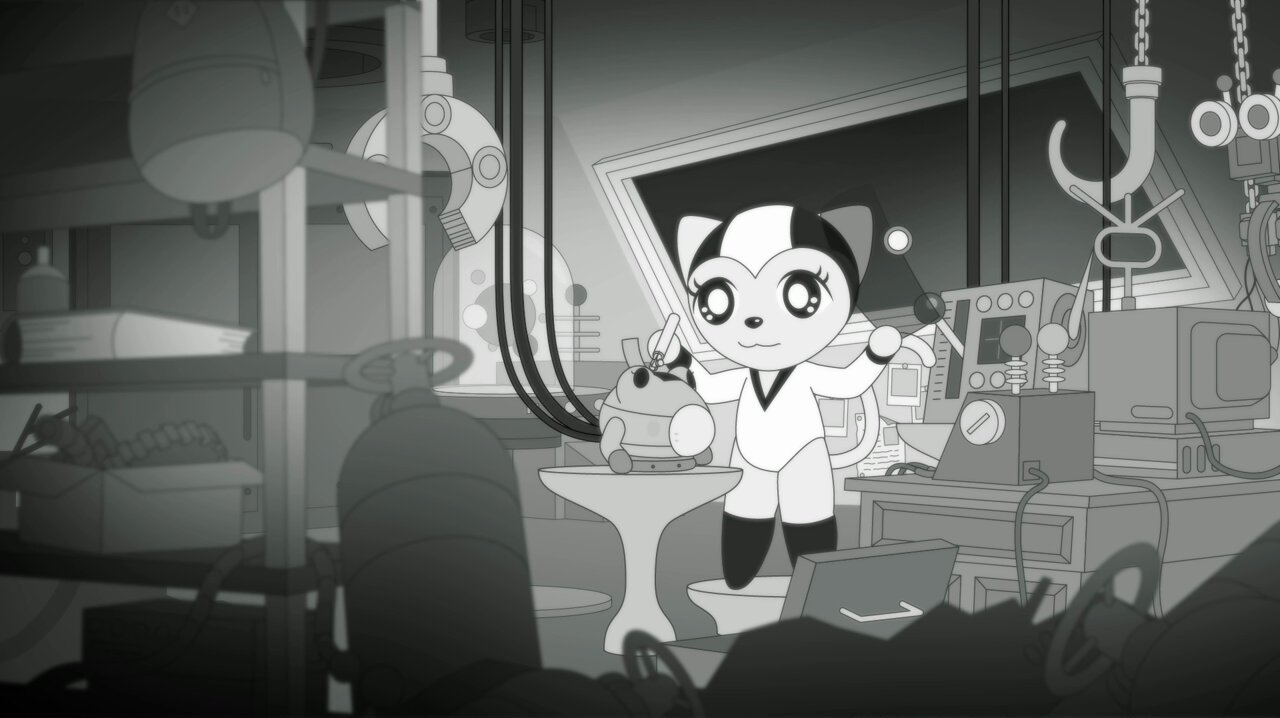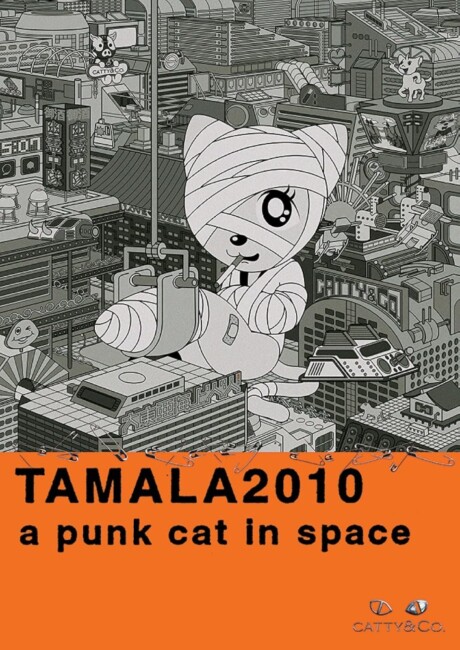Crew
Directors/Screenplay/Photography (b&w + some scenes colour)/Music – t.o.L., Producers – t.o.L., Kazuo Mio & Seiichi Tsukada, Music Performed by Trees of Life, Animation/Character Design – t.o.L. & Kentaro Nemoto. Production Company – Kinetique.
Plot
Meguro City, Tokyo, Cat Earth, the year 2010. Bored, the young cat Tamala defies her human adopted mother and takes a space journey. She crashlands on the planet Q, where she befriends and gets a ride with the cat boy Michelangelo to Hate City. There she is pursued, attacked and eaten by the sadistic dog motorcycle cop Kentauros. Michelangelo is afterwards visited by an aging man whose body is falling apart and told that Tamala was in fact born in the Cat Year 1869 but has been genetically engineered to remain one-year-old. She has become a pawn used to promote the products of the mega-conglomerate Catty & Co, which is in fact a new face of the ancient Minerva religion, and wishes to dominate the whole galaxy.
Tamala 2010 is an anime that comes from a two-person Japanese arts collective known as t.o.L., sometimes also known as Trees of Life. I have been unable to find almost any English-language information on t.o.L., excepting that the two artists are called K and Kuno and that their work branches across several media, including film, music and the graphic arts. t.o.L. have planned several Tamala 2010 spinoffs, including a film sequel, a tv series and a manga, although the only of these to have emerged so far have been Tamala on Parade (2007), a 24-minute video containing two Tamala short films.
Tamala 2010 is genuinely mind-boggling. As is frequently mentioned by reviewers, it seems like a demented take on the Canadian animated tv series Hello Kitty (1993). Maybe Hello Kitty fed through a sarcastic take on a shoujo anime. There is the appealing image of the young kitten heroine whose cuteness is deliberately punctured throughout – one minute she is cutely scratching trees while on a picnic or seductively stretching out across her boyfriend’s computer keyboard, the next kicking panhandlers in the head.
Even more amusingly, her lines are delivered in a high child-like voice and come out subtitled as “Fuck you, anaconda bitch mommy,” or where she offers herself to her male companion: “Me very tasty. Wanna eat me?” The logo for the production company Kinetique over the credits, for instance, is a picture of the cat with the legend (in English) “See Me, Hear Me, Eat Me.”

The whole exercise has the wilfully mind-bending quality of a modern underground comic – the sort that has the feel of being composed under the influence of illicit substances and which the artists usually sell and distribute themselves from a table at a comic-book convention. There are certainly some mind-bending moments – most memorable is that of a giant Colonel Sanders that stomps through the city extolling the virtues of meat. The animation is conducted at an incredibly minimalist level – all in black-and-white with occasional bursts of colour and a few moments of computer animation.
On the other hand, while the first half of Tamala 2010 at least starts out seeming like a real low budget, sarcastic guerrilla-produced take on a Japanese girl’s comic, the film suffers from a chaotic lack of discipline and during the last half disintegrates into complete incomprehensibility. Here the tone of sarcasm in the earlier half is forgotten – even Tamala herself drops from the main stage where we are given the impression that she has been eaten by the dog police officer.
In its place, the film jumps tracks to tell an entirely different story that involves a corporate conspiracy to take over the galaxy, the revelation that Tamala has been genetically-engineered and has appeared throughout history, ancient religions, time travel and something to do with a giant cat robot. Most of this is related to the character of Michelangelo/Moimoi by a disintegrating cat that may well be his own future self. Frankly, I found the film impossible to follow at this point and came out of it with little idea at all about what was going on. Certainly, what starts out well becomes a disappointingly incomprehensible mishmash by this point and not even a return of Tamala towards the end helps it recover.


